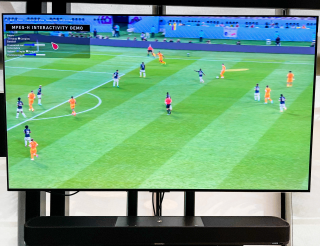The Brazilian SBTVD Forum recently finalized the technical evaluation phase of the TV 3.0 Project for the definition of the next-generation television system in Brazil. It comprised a detailed technical evaluation of all proposed technologies. As a result, the MPEG-H Audio system was selected as the sole mandatory audio codec for the future Brazilian broadcast system.
more info2022
-
-
Erlangen, Germany; Mont-Saint-Guibert, Belgium; London, UK: Fraunhofer IIS and intoPIX, the main JPEG XS standard patent holders, announce the creation and availability of a JPEG XS patent pool administered by Vectis IP. The new pool enables manufacturers, developers, and implementers to efficiently license JPEG XS standard essential patents using the framework of fair, reasonable, and non-discriminatory licensing. JPEG XS is the new lightweight low latency codec that can be used to improve connectivity in video workflows.
more info -
Erlangen, Germany / Hsinchu, Taiwan / Sao Paulo, Brazil: MediaTek, a leading fabless semiconductor company, and Fraunhofer IIS, primary developer of the MPEG-H 3D Audio standard, have once again collaborated for bringing the most advanced audio experience to consumer homes.
more info -
Latin America’s largest media group, Grupo Globo, is driving the change of media production, transmission, and consumption to a future-proof system. Now, they take another major step in the Digital TV evolution in Brazil and bring the SBTVD TV 2.5 standard into reality.
more info -
Developed at the Fraunhofer Institute for Integrated Circuits IIS and used around the world, the SHORE® facial detection and emotion analysis software library is turning 15 years old. Fraunhofer IIS is marking the occasion by releasing a new version with additional features. SHORE® uses highly efficient AI algorithms that enable image-based analysis of human expressions in line with German and EU data protection standards. The technology has a wide range of applications, including gaining insights into psychological disorders and researching the effects of advertising.
more info -

At WindEnergy 2022 in Hamburg, institutes of the Fraunhofer Cluster of Excellence for Cognitive Internet Technologies CCIT will demonstrate how sustainable energy can even be efficiently and sustainably monitored and maintained. With the Q-Bo® technology, Fraunhofer scientists show how bolted joints and screws, e.g. on the rotors or tower flanges of wind turbines, can be maintained without consuming large amounts of energy for installation, operation and transmission. This means that maintenance cycles for onshore and offshore wind turbines can be made many times more targeted and cost-efficient.
more info -

Fraunhofer Institute for Integrated Circuits IIS is proud to announce that the LC3plus codec has received the highly valued Hi-Res Audio Wireless certification issued by the Japanese Audio Society.
more info -

Fraunhofer supports its partners worldwide in setting up live transmissions of the football tournament with a new level of audio experience: Immersive sound and different personalization options.
more info -

Keeping things constantly connected to the internet costs energy — a lot of energy. Even small Internet-of-Things nodes run out of battery entirely in just a few weeks. All of this is changing with the RFicient® chip, developed by the Fraunhofer Institute for Integrated Circuits IIS, which saves power consumption by up to 99 percent. This development is a big step forward for the Internet of Things and has secured the Joseph von Fraunhofer Prize for the developer team. The Prize is awarded to employees of the Fraunhofer-Gesellschaft for their outstanding scientific achievements in solving application-related problems.
more info -

Robust transmission of sensor data for condition monitoring and smart metering – this is what recommends the wireless and standardized transmission technology mioty from the Fraunhofer Institute for Integrated Circuits IIS for applications in the Industrial Internet of Things (IIoT). But it can do even more: it enables hundreds of thousands of sensors to be connected via just one base station. This is a huge advantage, especially in the smart city and smart building sectors with many end devices. Using mioty, 3.5 million messages per base station can be read out and transmitted per day.
more info